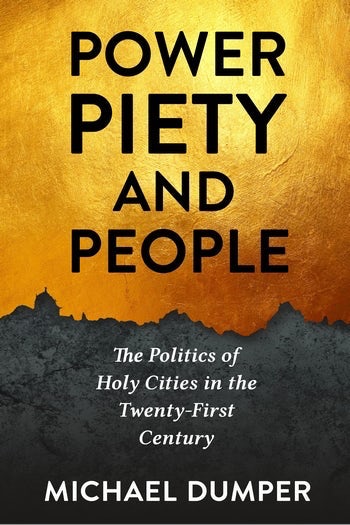by Mariam Ghorbannejad

If you have ever wondered what lies at the root of contemporary conflicts in holy cities, this book is an excellent starting point. Michael Dumper, Professor of Middle East Politics at the University of Exeter who has spent much of his career studying the Arab-Israeli conflict, focuses on five case studies through which he explores the reasons behind disputes, mapping a historical timeline of events until the present day and combining this with analysis of the actions of internal and external actors and primary ethnographic research to chart which have been more peaceful with possible explanations as to why this might be the case.
Dumper’s project aim is ‘to identify, explore, and explain the religious dimension to urban conflicts’ (p.10). To this end, he started by adopting and adapting the notion of ‘holy cities’ in the Middle East as defined by Francis Peters. He integrates this with the literature on the links between urban form and types of conflict and the works of conflict resolution scholars to gain a deeper understanding of the nature of these disputes.
The author begins by identifying cities that have sufficient characteristics of a holy city that would allow for useful comparison. These characteristics include the presence of ‘holy sites, a clerical hierarchy, income derived from religious activities, and religious practices that resonate beyond the city into the hinterland and diaspora’ (p.11).
Prior to discussing what characterises a holy city, the author establishes the features of any city, namely: density, proximity, specialisation, mobility, with competition over resources. Various permutations of these give rise to conflict. The theme of mobilisation based on class, linguistic, sectarian, or ethnic lines is one that is returned to many times throughout the book. How this mobilisation occurs, whether it be as a result of calls from local community leaders, politicians, members of the diaspora or the action of international organisations such as the United Nations makes for interesting reading. The proximity of holy sites, especially those of two different religions, or the paths of processions pertaining to certain religious festivals is discussed in relation to how this may have caused or exacerbated tensions in holy cities.
The city of Jerusalem, holy in Judaism, Christianity and Islam, is chosen to explore the notion of holy cities in general and the key issues examined here are utilised as lenses through which to view the other case studies: Cordoba, Spain; Banaras, India, Lhasa, Tibet and George Town, Malaysia.
Dumper highlights five ‘elements in conflicts that are generated by the associations a city has with religious beliefs and practices’ (p.209); they are: the close proximity of religious sites to each other; the ownership of land and property by religious communities; how competition between different communities over access to land, revenue streams, and other resources is exacerbated by the density of a city; religious leaderships of senior clerical figures becoming key political actors due to weak state institutions; and external interventions on religious grounds.
Reading the book is like taking a tour around the holy cities through the ages, where important religious sites are described in detail and you are able to visualise the form of conflict that has occurred there. There are black and white photos accompanying each chapter although the book would benefit from colour pictures and more of them. It would add another dimension to the analysis and help the reader imagine how disputes might have arisen. Photos comparing the sites of the holy city in the past with what they look like nowadays would make the book more attractive and any change in appearance lends itself to further explanation based on the elements previously outlined. In terms of history, economics and politics, the book covers vast ground. It would benefit, though, from more primary ethnographic data so that historical and secondary source information could be verified or questioned. This paucity of primary data was likely a result of a limited research budget rather than an omission on the part of the author.
The book is very well-written; it is easily accessible to a non-academic audience and it is not a prerequisite to be an expert in cities, comparative religion, conflict or peace studies to understand its content. The designation of chapters with clear and explicit aims alongside frameworks that are outlined in sufficient detail so as to be informative and engaging but not overwhelming constitutes a coherent read. I would recommend the book to anyone with an interest in the urban dimension of conflict in cities associated with religion, travellers with a fascination for history and people who would enjoy learning more about contentious issues in holy cities around the world.






